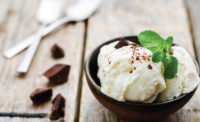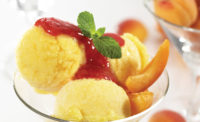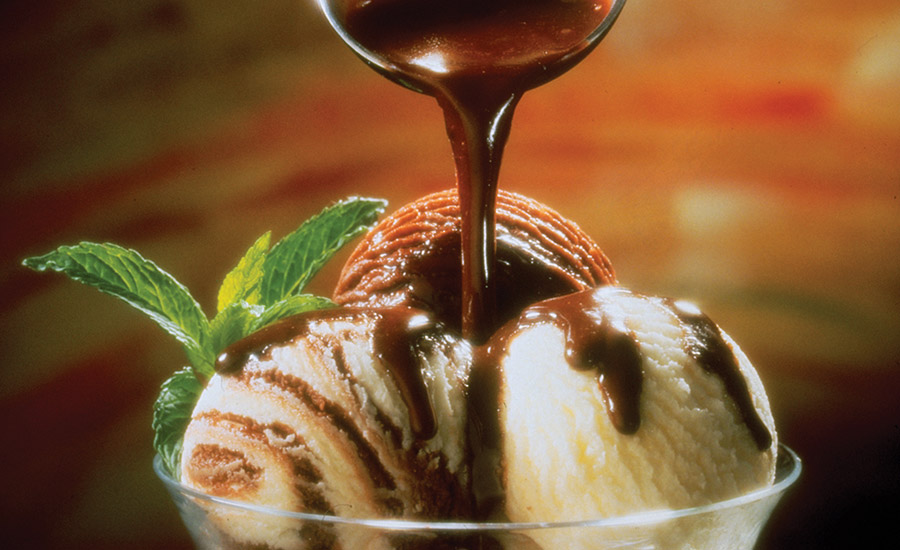Frozen desserts balance virtue and vice
But taste still reigns supreme in this indulgent category


Photo courtesy of U.S. Highbush Blueberry Council

Photo courtesy of Cargill

Photo courtesy of Cargill




According to 2017 ice cream research from global market research firm Mintel, only 11% of U.S. consumers claim to be cutting back on ice cream or frozen treats for health-related reasons. What’s more, 10% of consumers went on record as actively avoiding healthy frozen dairy treats because, well, frozen dairy is supposed to be a treat, not a health food.
But if consumers are so willing to throw dietary caution to the wind, how do you explain the runaway success of Halo Top?
Halo Top is, of course, the ingenious invention of Los Angeles-based Eden Creamery: a “healthy” fiber- and protein-fortified ice cream that occupies that elusive space between good-for-you and decadent. Sweetened with erythritol and organic stevia and cane sugar, the frozen phenomenon packs only 240 to 360 calories per pint — daring consumers to go whole hog on the whole container.
And it looks as though that’s what many have done. In the 52 weeks ending June 11, 2017, Halo Top’s sales rose 2,484.9% to $160.9 million, according to a June 29 AdAge.com article, citing data provided by Chicago-based market research firm Information Resources Inc.
And though it’s inarguable that the “healthy” image Halo Top cultivates — with its higher levels of protein and fiber, lower calorie content and nonthreatening ingredient deck — helps drive this growth, just as important to its ascent, if not more so, are its hedonics: People can’t stop eating this stuff because it tastes good.
As more frozen-dairy formulators follow Halo Top’s lead, that’s the circle they’ll have to square. Or, as Matt Plaza, application technologist, sweet flavors for Hoffman Estates, Ill.-based Sensient Flavors, put it, “As the conversation shifts from weight loss to overall wellness, frozen dairy manufacturers are forced to balance decadence with the nutritional goals that their consumers seek.”
Healthy halo
Halo Top has the industry in its thrall.
“Every frozen-dairy CPG client we’ve been formulating for has been for increasing proteins and cutting sugars as they chase Halo Top,” said Thom King, CEO and president, Icon Foods, Portland, Ore. Having launched its own high-protein, low-sugar ice cream dry mix at this year’s SupplySide West, King and Icon find healthy ice creams “a very exciting category.”
And the excitement is justified. After all, Halo Top’s success proves that “you can have a reduced-sugar frozen dessert and still call it decadent,” said Ravi Nana, polyols technical service manager, Cargill, Wayzata, Minn. “Here you have this low-calorie, low-sugar ice cream that consumers love. It’s outselling brands like Ben & Jerry’s and Häagen-Dazs and has become America’s best-selling pint.”
Reframing the debate
Halo Top’s success has the industry raising questions about just what “decadence” — or “indulgence” or “premium” — really means in frozen dairy today. For Brian Surratt, a senior scientist at Cargill, products qualify as decadent by providing “characteristics described in terms such as ‘rich’ or ‘gratifying,’ ‘velvety,’ ‘creamy,’ ‘silky’ or ‘smooth. Some consumers go even further, associating indulgence with guilty or sinful pleasures — meaning that if it tastes this good, it has to be really bad for me, nutritionally speaking,” he said.
Yet this is just the zero-sum equation that brands like Halo Top aim to recalculate. Why, they ask, does delicious frozen dairy have to exact a nutritional toll? They answer, in part, by incorporating low-calorie sweeteners, prebiotic fiber and milk protein concentrates that are better, if not outright good, for you into their formulations. But they’re also taking advantage of an opportunity to reframe the definition of “healthy.”
To wit, whereas “healthy” was once a quantifiable trait measured in nutrient RDAs and kilocalories, the term today is more a matter of perception and impression. For many, “healthy” means “pure,” “clean” and “natural” — themselves fuzzy concepts. But by their fuzzy definition, a product rich in “real” sugar and “pure” cream can seem even healthier than one that may have a more virtuous Nutrition Facts panel, but that came about its virtue via “artificial” ingredients.
Ingredients you can feel good about
In this context, it’s easy to see how “indulgence,” “decadence” and “premium” can also signal “wholesome” or even “healthy.” And the common denominator linking them is the “quality” of their constituent ingredients.
Of course, quality is also a subjective notion. But a good benchmark in “premium, health-focused ice cream,” said Jamie Wilson, director, marketing and culinary, Parker Products, Fort Worth, is that quality comes from “full-fat products and high-quality sweeteners with premium, culinary ingredients.” By using such ingredients — “sustainable whole foods,” she called them — “brands can achieve decadence while still offering healthy claims.”
If consumers seem willing to accept that a single ingredient can deliver decadence and health, perhaps that’s because having the best of both worlds is something they’ve come to expect.
“In today’s market of endless choices, consumers have a higher standard for taste,” Plaza observed. “For consumers, especially millennials, rewarding themselves with indulgent food has become common practice. When there are ‘cheat days’ involved, the choice of treat depends on how craveable or indulgent the ingredients and flavors are.”
Promoting inclusion
Nowhere is that relationship more apparent, at least in frozen dairy, than in the choice of inclusions — which “undoubtedly shout ‘decadent,’” Plaza said.
John Pimpo, sales manager – East, Gertrude Hawk Ingredients, Dunmore, Pa., agrees, and he’s seen inclusions increase an ice cream’s decadence quotient “in a variety of fashions.” For example, “a nostalgic nod toward flavors of yesteryear” has reinvigorated interest in classic s’mores and malt-flavored inclusions.
Pimpo’s company has also developed a peanut butter and strawberry jelly cup that “takes you right back to the third grade lunchroom — minus the wedgies,” he said. Its milk marshmallow cup — with a milk exterior and confectionary marshmallow center — “puts you at the campsite,” he added. And don’t forget the liquor cabinet.
“There’s real interest in alcohol-infused inclusions,” Pimpo said, “like our brown-butter bourbon truffles. Milk exterior with a brown-butter bourbon caramel center. Pure indulgence.”
Inclusions also let dairy developers play with texture. Ice cream is supposed to be silky-smooth, but “with cake or cookie pieces incorporated throughout, the consumer can enjoy savoring the contrasting textures: rich, smooth and creamy dairy, and crunchy cookie or cake mix-ins,” said Anton Angelich, group vice president, Virginia Dare, Brooklyn, N.Y. “It’s having your cake and eating it, too!”
With texture playing a more important role in how consumers experience food, Plaza noted that Sensient Flavors is repeatedly receiving requests for larger, chunkier inclusions the consumer will definitely notice.
“There’s been a shift from filling a pint with as many tiny pieces as possible to including fewer large pieces for the consumer to ‘dig’ for — creating an experience almost independent from the ice cream,” he said.
Healthy dose of indulgence
But even over-the-top inclusions can’t disregard consumers’ wellness concerns.
“Some of our customers are coming to us to investigate ‘smart indulgence’ — formulating decadent inclusions with a nod to clean ingredients,” Pimpo said.
That’s meant a large shift toward the absence of partially hydrogenated oils, high fructose corn syrup and artificial colors and flavors.
“Taking it to an even higher level,” he said, “are requests for RSPO” — Roundtable on Sustainable Palm Oil — “oils and no GMOs.”
Wilson noted that her company increasingly relies on clean sweeteners such maple or agave and “sought-after” ingredients such as ancient grains: quinoa, amaranth, spelt and more.
“We particularly like ancient grains as culinary ingredients with complex, surprising qualities, as well as good nutrition and trend appeal,” she said. “These make for a particularly decadent formulations in clusters with more traditional indulgent ingredients like dark chocolate.”
With chocolate a veritable antioxidant superfood these days, the more that shows up in frozen dairy, the merrier.
“For chocolate, decadence means a strong chocolate impact, whether with a thicker, high-cacao chocolate coating on the ice cream or more highly flavored chocolate inclusions,” explained Tom Jablonowski, senior technical services manager, Cargill Cocoa and Chocolate, Wayzata, Minn.
Specialty cocoas can also “drive a unique color or flavor impact” in premium formulations, he said.
“High-fat cocoas in the 22-to-24% fat range can provide a richness of chocolate flavor and extra creamy sensation in an ice cream,” he said.
Icon’s King called attention to the recent launch of his company’s sugar-free chocolate chunk inclusions for frozen dairy — a product he predicts will be a big seller going into 2018. In the variegate space, the company offers a low-sugar, keto-friendly caramel topping made with allulose, monk fruit sweetener, butter and salt.
“This topping is extremely decadent,” he said, “while addressing clean-label sugar reduction” — a goal he sees as “poised to take off as low-sugar, high-protein frozen desserts skyrocket.”
But to achieve true healthful indulgence, it always helps to go back to basics.
“The interest in ‘natural’ over ‘artificial’ ingredients has food manufacturers looking for real sources of color and flavor,” said Tom Payne, industry specialist, U.S. Highbush Blueberry Council, San Mateo, Calif. “Many products use blueberry visuals as signifiers of health, goodness, naturalness and other positive virtues that manufacturers want to associate with their products.”
Put healthy indulgence to work
Formulating with delicious and nutritious inclusions doesn’t involve challenges beyond those that conventional inclusions impose — which is to say, the inclusions “have to be carefully formulated to deliver an appealing texture: neither too soggy nor too hard,” Wilson said. Her company works with dairy customers “to create inclusions that have an appropriate moisture barrier and lightness of texture so that they can be easily integrated into existing manufacturing processes.”
Pimpo advocated working with low-melt inclusions, which provide the “smooth, soft, indulgent” melt consumers expect of chocolatey inclusions.
And Payne was quick to praise the utility of blueberry ingredients.
“Blueberry purée is wonderful in ice cream,” he said. “Interesting patterns and squiggles are possible, as is everything from ‘blueberry-pie’ ice cream to chocolate-blueberry ice cream sandwiches with chunks of blueberries in vanilla ice cream served between two chocolate cookies.”
Manufacturers could grind frozen blueberries directly into mixes for blueberry identity, too. And with their naturally high sugar levels, blueberry stir-ins and dried or crushed blueberry inclusions can counter the sometimes sour taste of products such as frozen yogurt.
That balance of taste — perhaps even more than any good-for-you appeal — is what keeps consumers coming back to the frozen dairy aisle.
“The key is that these products still have to deliver an indulgent flavor profile that fits desires for a treat — and that’s precisely what most successful clean-label ice cream brands do,” Wilson said.
Looking for a reprint of this article?
From high-res PDFs to custom plaques, order your copy today!










